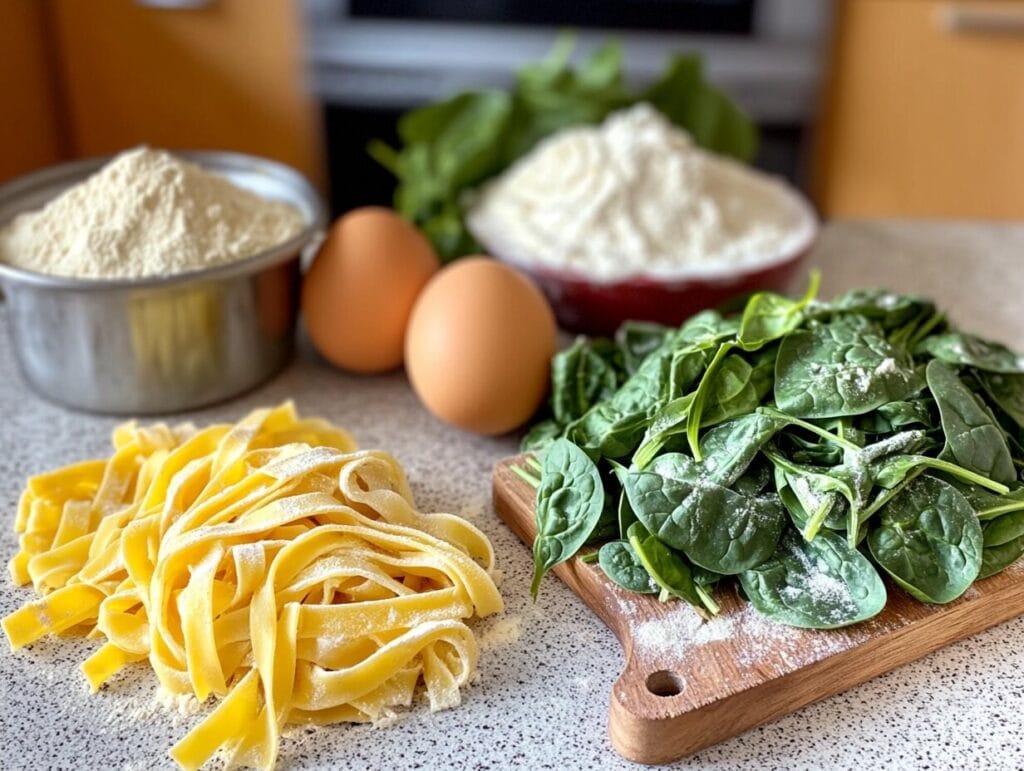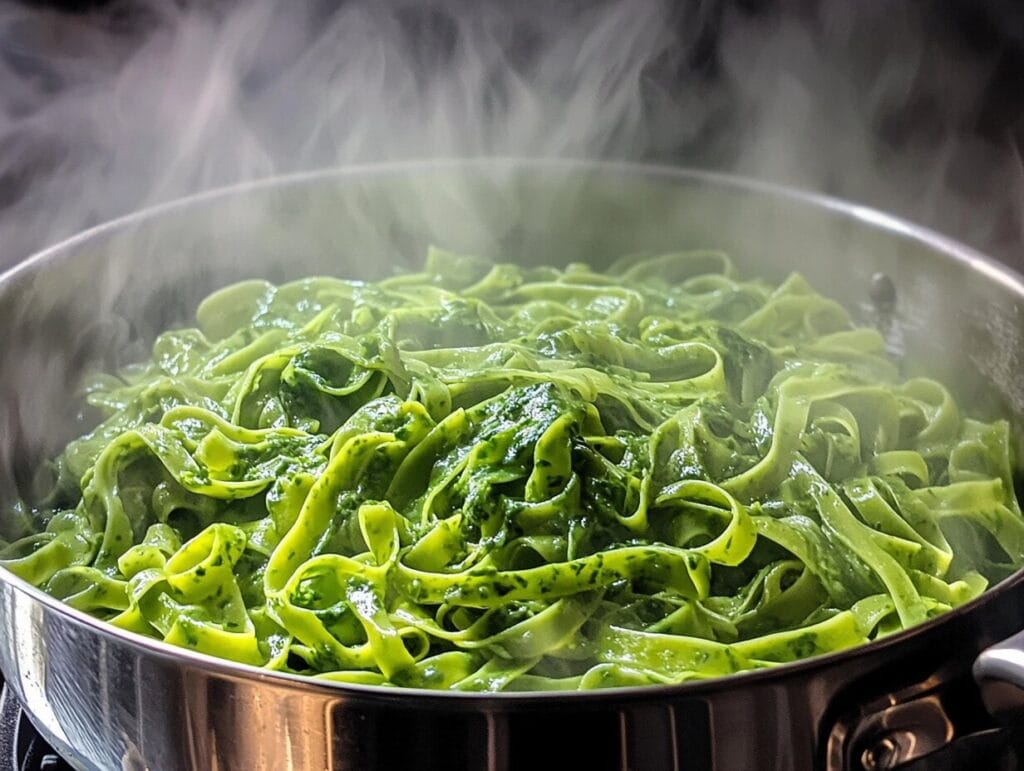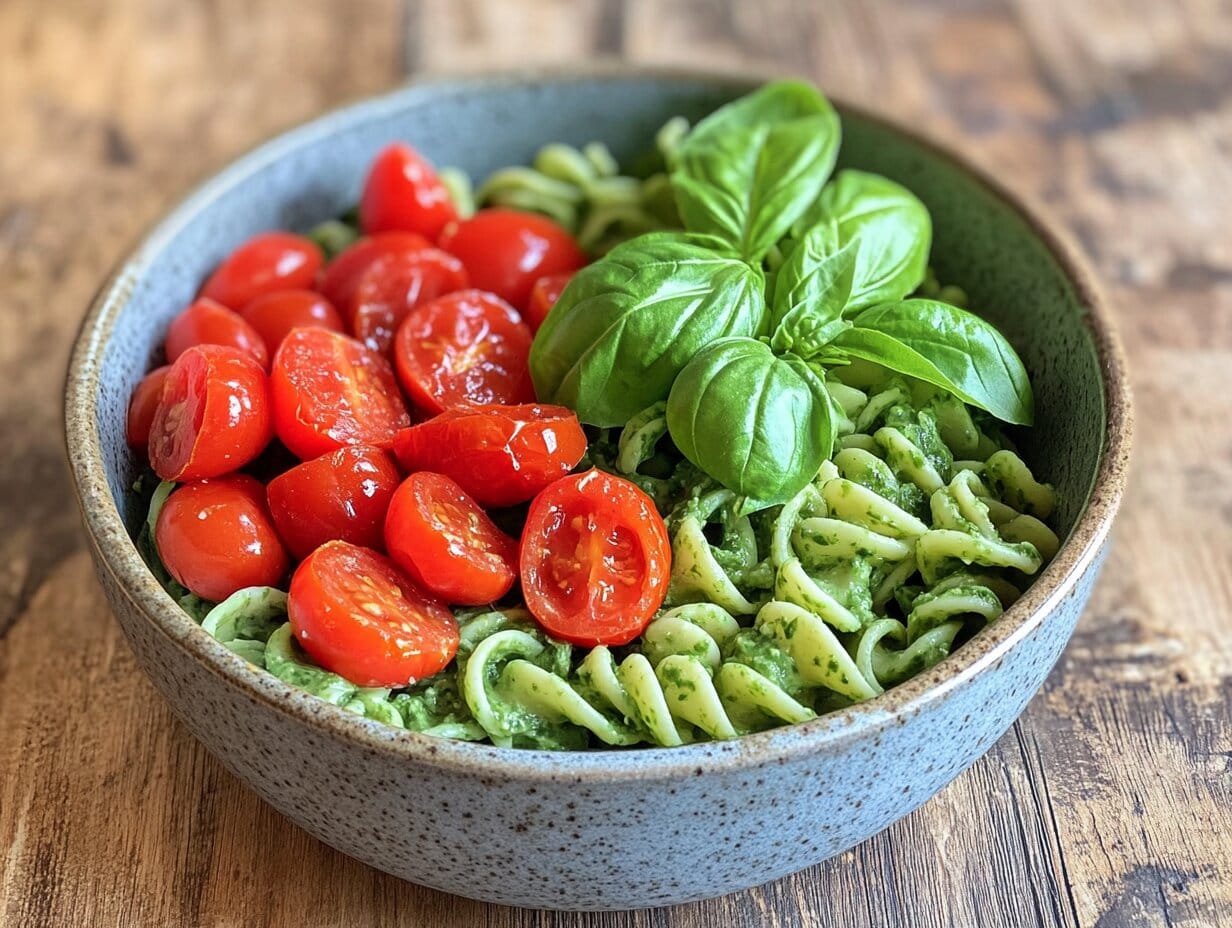Introduction
Is spinach pasta good for you? This is a question many health-conscious individuals ponder as they explore alternatives to traditional pasta. Spinach pasta combines the comforting appeal of pasta with the nutrient-rich profile of spinach, making it a popular choice for families and food enthusiasts alike. But how much healthier is it, and does it justify the hype?
In this article, we’ll explore whether spinach pasta is truly good for you by examining its nutritional content, benefits, potential drawbacks, and how it fits into various diets.
Nutritional Composition of Spinach Pasta

Nutrients in Spinach Pasta
So, is spinach pasta good for you nutritionally? The addition of spinach provides vitamins like A and C, as well as minerals such as iron and magnesium. While it still contains carbohydrates similar to traditional pasta, its enhanced nutrient profile can make it a better option for those looking for extra vitamins in their meals.
Comparison with Regular Pasta
Compared to regular pasta, spinach pasta stands out due to its vibrant color and slight nutritional edge. However, it’s worth noting that the primary ingredient is often wheat, meaning the spinach content may not be substantial enough to make a significant difference unless consumed as part of a balanced diet.
Role of Spinach in Enhancing Nutrition
Spinach is celebrated for its antioxidant properties, fiber, and essential vitamins. Incorporating spinach into pasta offers an easy way to consume this leafy green, especially for those who don’t typically enjoy it on its own. This raises the question: Is spinach pasta good for you as a consistent part of your diet? The answer largely depends on how it’s prepared and consumed.
Health Benefits of Spinach Pasta
High Vitamin Content
Spinach pasta is an excellent source of vitamins, particularly vitamin A and vitamin C. These vitamins are essential for immune support, skin health, and vision. Vitamin A, derived from beta-carotene in spinach, contributes to eye health and may lower the risk of age-related vision issues.
Rich in Antioxidants
Spinach pasta provides antioxidants, such as lutein and zeaxanthin, which are beneficial for eye health. These compounds help protect against oxidative stress, which can lead to chronic diseases. Additionally, antioxidants may play a role in reducing inflammation and promoting overall well-being.
Low-Calorie and Weight Management Benefits
For those aiming to manage their weight, spinach pasta offers a slightly lower calorie alternative to traditional pasta, depending on the recipe. The added spinach increases fiber content, which helps with satiety, reducing the likelihood of overeating.
Potential Drawbacks of Spinach Pasta
High Carb Content
Although spinach pasta offers additional nutrients, it is still primarily a carbohydrate-based food. This can be a concern for individuals monitoring their carb intake, such as those with diabetes or those following low-carb diets.
Gluten Concerns
Most commercially available spinach pastas are made with wheat flour, which contains gluten. This can be problematic for people with celiac disease or gluten sensitivities. Fortunately, gluten-free options are available, though they may differ in texture and taste.
Overestimating Health Benefits
A common pitfall with spinach pasta is assuming it’s significantly healthier than it is. While the spinach adds nutrients, the overall profile of the pasta doesn’t make it a “superfood.” It’s important to view spinach pasta as a slightly improved version of traditional pasta, rather than a health food miracle.
How Spinach Pasta is Made
Ingredients Used
The basic ingredients in spinach pasta include wheat flour, spinach (puree, powder, or fresh), eggs (optional for non-vegan varieties), and sometimes water. Commercially, preservatives or artificial colors may be added to enhance shelf life or appearance.
Industrial Versus Homemade Spinach Pasta
Industrial spinach pasta is often more convenient but may contain additives or less spinach than expected. On the other hand, homemade spinach pasta allows for greater control over the ingredients and spinach content, ensuring a fresher, more nutritious product.
Recipe for Making Spinach Pasta at Home
To make spinach pasta at home, you’ll need:
- 2 cups of all-purpose or whole wheat flour
- 1/2 cup of spinach puree
- 2 eggs (or water for vegan alternatives)
Instructions:
- Blend fresh spinach into a smooth puree.
- Mix the flour and eggs (or water) into a dough.
- Knead the dough, adding the spinach puree gradually.
- Roll out the dough and cut it into desired shapes.
- Cook in boiling water for 3–5 minutes.
Homemade spinach pasta is not only healthier but also customizable, allowing you to adjust for taste and dietary needs.
Spinach Pasta vs. Whole Wheat Pasta
Nutritional Differences
When comparing spinach pasta to whole wheat pasta, both have unique advantages. Whole wheat pasta is higher in dietary fiber, aiding digestion and promoting heart health. Spinach pasta, however, provides additional micronutrients like vitamin A, vitamin C, and iron due to the spinach content.
Suitability for Different Diets
Whole wheat pasta is often the better choice for individuals seeking higher fiber content, while spinach pasta appeals to those looking for a slight nutrient boost with a similar calorie profile. Spinach pasta may also appeal more to children or picky eaters because of its colorful appearance and mild taste.
Taste and Texture Comparison
Whole wheat pasta has a nuttier flavor and denser texture, while spinach pasta offers a more neutral taste with a slightly softer consistency. This makes spinach pasta a versatile option for a wider range of recipes.
Spinach Pasta for Weight Loss
Role in Calorie Control
Spinach pasta can be a helpful component in weight loss diets when consumed in moderation. While it has a similar calorie count to traditional pasta, the added fiber from spinach promotes feelings of fullness, potentially reducing overall calorie intake.
Low-Carb Alternatives
For those following low-carb diets, spinach pasta may not be the ideal choice due to its carbohydrate content. Instead, alternatives like zucchini noodles or shirataki noodles may offer better options. However, incorporating spinach pasta into balanced meals with protein and vegetables can still support weight management.
Balancing Pasta with Other Foods
Pairing spinach pasta with nutrient-dense foods like lean proteins (chicken, fish, or tofu) and plenty of vegetables creates a balanced, satisfying meal. Avoid high-calorie, creamy sauces, and instead opt for lighter options like olive oil and garlic or tomato-based sauces to keep the meal diet-friendly.
Spinach Pasta for Special Diets
Vegan and Vegetarian Options
Spinach pasta is naturally suitable for vegetarians, and vegan versions are readily available or can be made at home by omitting eggs. The spinach adds essential nutrients like iron, which is particularly beneficial for plant-based diets.
Gluten-Free Spinach Pasta
For individuals with gluten sensitivities, gluten-free spinach pasta made with alternatives like rice or chickpea flour is widely available. While the taste and texture may differ slightly, these options still provide the nutritional benefits of spinach.
Keto-Friendly Versions
Traditional spinach pasta is not suitable for ketogenic diets due to its carbohydrate content. However, keto-friendly alternatives using almond or coconut flour mixed with spinach are available and can be homemade for a low-carb, nutrient-rich option.
Cooking with Spinach Pasta

Best Cooking Methods
Spinach pasta cooks faster than traditional pasta due to its softer texture. Boil it for 2–4 minutes, ensuring it doesn’t overcook and become mushy. A quick rinse with cold water after cooking helps retain its vibrant green color.
Pairing Sauces and Toppings
Spinach pasta pairs beautifully with light sauces like lemon-butter, olive oil with garlic, or marinara. For a heartier dish, pesto or cream-based sauces also work well, but they should be used sparingly to maintain nutritional balance. Adding sautéed vegetables or grilled protein enhances both flavor and nutrition.
Tips to Retain Nutrients During Cooking
To maximize the nutritional benefits of spinach pasta, avoid overboiling, which can degrade some vitamins. Use the cooking water to thin out sauces, as it retains some nutrients leached during boiling.
Spinach Pasta in Different Cuisines
Italian Dishes with Spinach Pasta
Spinach pasta naturally fits into traditional Italian cuisine. Popular dishes include spinach fettuccine Alfredo, spinach lasagna, and spinach pasta primavera. The vibrant green pasta not only enhances the visual appeal of these dishes but also complements classic Italian flavors like basil, garlic, and tomatoes.
Fusion Cuisine Ideas
Spinach pasta can be used creatively in fusion cuisine. For example:
- Asian Spinach Noodles: Tossed with soy sauce, sesame oil, and stir-fried vegetables.
- Mexican Spinach Pasta: Combined with spicy chipotle sauce and black beans for a unique twist.
- Mediterranean Spinach Pasta Salad: Featuring olives, feta cheese, and a lemon vinaigrette.
Global Recipes Featuring Spinach Pasta
Spinach pasta is versatile enough to adapt to various global recipes. It can be used in hearty soups, cold salads, or even baked pasta casseroles, making it a favorite among food enthusiasts worldwide.
Frequently Asked Questions
Nutritional Myths About Spinach Pasta
Is spinach pasta healthier than regular pasta?
While spinach pasta is slightly more nutritious due to the added spinach, it is not a significantly healthier option. It should be part of a balanced diet rather than a standalone solution for better health.
Can Kids Eat Spinach Pasta?
Yes, spinach pasta is a kid-friendly option. Its mild taste and appealing color make it a great way to introduce vegetables into their meals. It can be paired with kid-approved sauces like tomato or cheese for an enjoyable dish.
Is Spinach Pasta Diabetic-Friendly?
Spinach pasta can be part of a diabetic-friendly meal when consumed in moderation and balanced with protein and non-starchy vegetables. However, it is still a source of carbohydrates, so portion control is crucial.
Does Spinach Pasta Taste Different?
Spinach pasta has a slightly earthier flavor compared to regular pasta, but it is subtle and easily adaptable to various sauces and seasonings.
Can I Freeze Spinach Pasta?
Yes, spinach pasta can be frozen, either cooked or uncooked. To freeze uncooked pasta, dust it lightly with flour to prevent sticking, and store it in an airtight container.
How Much Spinach Is in Spinach Pasta?
The actual spinach content varies between brands. Some may contain minimal spinach, so it’s essential to check the ingredient list to ensure you’re getting a product with genuine nutritional benefits.
Consumer Tips for Buying Spinach Pasta
Reading Labels for True Spinach Content
When purchasing spinach pasta, carefully read the ingredient list to determine the proportion of spinach. Avoid brands with artificial colors or minimal spinach content.
Best Brands for Quality and Taste
Some reputable brands offer high-quality spinach pasta with authentic flavors and no artificial additives. Look for products made with organic ingredients for added assurance.
Avoiding Additives and Preservatives
Choose spinach pasta with minimal ingredients—ideally just flour, spinach, and water. Avoid products with long ingredient lists, which may include unnecessary additives or preservatives.
Environmental Impact of Spinach Pasta
Sustainable Farming Practices for Spinach
Brands that use sustainably farmed spinach contribute to reducing environmental impact. Supporting such companies helps promote eco-friendly agricultural practices.
Packaging and Waste Concerns
Opt for brands with biodegradable or recyclable packaging to minimize waste. Homemade spinach pasta also reduces reliance on single-use packaging.
Supporting Eco-Friendly Brands
Research and support companies that prioritize sustainability in both their sourcing and manufacturing processes. This ensures you’re making a positive impact with your purchase.
Spinach Pasta vs. Zoodles (Zucchini Noodles)
Calorie Comparison
Spinach pasta contains more calories per serving compared to zucchini noodles, which are almost calorie-free. For weight loss, zoodles may be the better option.
Nutritional Analysis
Spinach pasta offers more complex carbohydrates and iron, while zoodles provide hydration and are rich in vitamin C. Each has its own advantages depending on dietary needs.
Suitability for Low-Carb Diets
Zoodles are ideal for low-carb diets, while spinach pasta, being carb-heavy, is better suited for balanced meals that include physical activity.
Related Reading on Spinach Pasta and Its Benefits
To further explore the topic of spinach pasta and its nutritional benefits, consider diving into these related articles:
- Mushroom Spinach Pasta: A Nutritious and Delicious Recipe: Learn how to combine spinach pasta with mushrooms for a balanced and delicious meal.
- Green Spaghetti: A Delicious Twist to Classic Pasta: This article provides a creative take on green pasta dishes, offering inspiration for flavorful recipes that incorporate healthy ingredients.
- What Does Green Pasta Taste Like?: Discover the unique flavor profile of green pasta, including spinach varieties, and how it compares to traditional pasta.
Conclusion
Spinach pasta is a nutritious and versatile alternative to traditional pasta. While it’s not a miracle health food, it offers added vitamins, fiber, and antioxidants that can contribute to a balanced diet. Its mild taste and vibrant color make it a popular choice for creative dishes across global cuisines.
Whether you choose it for its nutritional value, taste, or aesthetic appeal, spinach pasta can be a valuable addition to your meals when consumed mindfully and in moderation.
